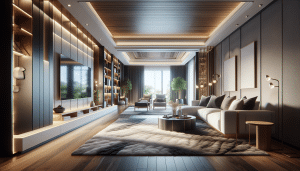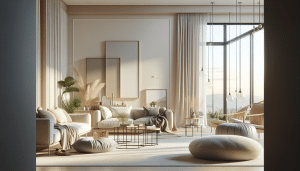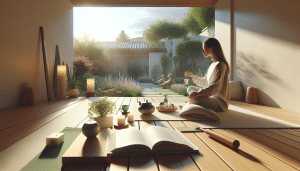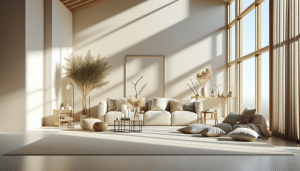Can You Transform Your Living Room with Minimal Effort
Jessica White September 23, 2025
Explore how subtle changes can completely elevate your living room. This guide delves into trending decor ideas, smart furniture options, creative lighting, and easy upgrades to inspire a refreshed and stylish space with minimal stress.
Embracing Modern Interior Design for Daily Life
Modern interior design isn’t only about sleek lines and neutral colors. It encourages the use of open spaces, natural light, and thoughtfully selected furniture. A living room can feel more spacious and comfortable when unnecessary items are removed and core pieces are carefully arranged. This approach maximizes every square foot and brings a sense of harmony, no matter the room size. By weaving in elements like contemporary art or geometric rugs, the space tells a story that feels personal and welcoming. These small updates, though seemingly modest, can make a dramatic difference in how a room looks and functions (Source: https://www.interiordesign.net).
One easily accessible keyphrase in lifestyle trends is ‘open-concept living’. More homeowners are knocking down unnecessary barriers and letting rooms flow together. This trend aligns perfectly with a minimal effort approach, as simply repositioning furniture or removing one bulky item can visually open up a closed-off area. Plants and soft lighting contribute to warmth while maintaining the airy feel. By choosing a lighter palette and multi-use pieces, it’s possible to blend beauty and practicality effortlessly.
Minimalist living doesn’t mean sterile or boring. Instead, it focuses on purpose and function. Decorative cushions, throws, and curated magazines add color and personality without overwhelming the senses. Incorporating natural textures such as wood or linen invites calm. If the living room doubles as a workspace or play area, flexible furniture solutions ensure tidiness and versatility. This makes modern interior design a practical style for a broad range of lifestyles (Source: https://www.architecturaldigest.com).
Creative Furniture Solutions for Smaller Spaces
Small living rooms can still appear expansive with smart furniture placement and multi-functional pieces. Consider a sofa-bed, storage ottoman, or nesting tables for maximizing utility without clutter. These versatile pieces keep the area organized and presentable. Each item should serve more than a decorative purpose—think of hidden drawers under benches or fold-out desks. Furniture innovation has been a gamechanger for those seeking efficiency and style in limited square footage (Source: https://www.houzz.com).
Another strategy involves modular seating that can be easily rearranged for guests or quiet moments alone. Modern sectionals and armless chairs allow for flexibility in layouts, accommodating different moods and activities. Colors in greys, blues, and earthy tones help reflect light and make rooms seem more expansive. Furniture shopping has shifted online, making it easier to compare layouts and visualize various pieces in augmented reality. This technology allows users to preview changes before making decisions, reducing costly mistakes.
Vertical storage is a hidden gem in small space design. Wall-mounted shelves above sofas, slim bookcases, or floating TV units make full use of vertical real estate. This keeps valuable floor space free for movement or relaxation. By choosing furniture with slim profiles but ample storage, every inch counts toward functionality. Clever arrangements of large and small pieces can actually draw the eye upward, helping ceilings appear taller and overall ambiance lighter (Source: https://www.apartmenttherapy.com).
Lighting as a Mood Setter and Design Statement
Lighting can shape the perception of an entire living room. Natural daylight streaming in through sheer curtains highlights colors and textures. However, artificial lighting choices transform the space after sunset. Consider layered approaches—overhead fixtures, wall sconces, and table lamps—to create a dynamic and inviting environment. Dimmable LED strips add versatility and allow the same room to serve many functions.
Indirect lighting, such as hidden strips behind bookcases or cabinets, casts a soft glow and reduces harsh shadows. Pendant lamps or floor lamps can become focal points, offering both art and illumination in one. The placement and selection of lighting make a room feel cozier, more productive, or simply restful, depending on the needs of its occupants. Modern fixtures aren’t just functional; they’re a reflection of personal taste, contributing to the ambiance as much as anything else (Source: https://www.energystar.gov/products/lighting_fans).
Color temperature matters too. Warm white bulbs foster relaxation, which makes them perfect for evenings spent lounging or reading. Higher color temperatures help with tasks or highlight artwork. Mixing task and accent lighting serves people who want to adapt their space for different uses throughout the day. Recent advances in smart home technology now allow residents to control not just brightness, but also color via apps or voice assistants—a genuine lifestyle upgrade for entertainment zones.
Easy Decor Upgrades That Make a Big Impact
Sometimes, the simplest upgrades deliver the greatest results. Swapping out throw pillow covers, adding art prints or mirrors, and incorporating seasonal plants can revitalize a room. Mirrors in particular are known for making small spaces appear larger and brighter by reflecting light throughout a space. Art doesn’t have to be expensive—plenty of online marketplaces offer affordable prints and digital downloads (Source: https://www.vam.ac.uk/articles/a-brief-history-of-interior-design).
Rugs define seating areas and can bring all the elements of a room together. Choose materials and colors that contrast with your main furniture for dynamic effect. Plants bring outdoor freshness inside and have a secondary benefit: air purification. Low-maintenance houseplants such as snake plant or pothos thrive in various lighting conditions and add a lively touch without much commitment.
Wall decals and removable wallpaper have also become increasingly popular in lifestyle magazines for instant makeovers. For renters and those hesitant to commit to bold changes, these options provide color, pattern, and design freedom without permanent alterations. Shelf styling with curated objects and minimal clutter presents a cared-for look and allows easy rotation with the seasons or shifting moods (Source: https://www.goodhousekeeping.com/home/decorating-ideas/g2141/living-room-decorating-ideas).
Balancing Comfort, Entertainment, and Personal Style
Creating a living room that caters to both relaxation and entertainment means considering practicalities like seating arrangements, media access, and acoustics. Soft, textured fabrics offer comfort, while carefully positioned speakers or smart TVs enhance movie nights or gatherings. Effective zoning—using area rugs, lighting, or small shelves—lets one room serve many purposes, even in tight spaces (Source: https://www.nytimes.com/guides/realestate/living-room-upgrades).
Personal touches cannot be overstated. Framed photos, souvenirs from travels, and handmade crafts turn an ordinary room into an expression of unique taste and stories. These individual elements encourage conversation and form strong connections between inhabitants and their home. Regularly rotating a few pieces keeps the environment fresh without major purchases or commitments.
Finally, balance is found by respecting the needs of everyone who uses the space. Whether accommodating a child’s toys, a pet’s favorite chair, or a friend’s gaming setup, versatility is key. Storage baskets and multi-use furniture keep clutter at bay, while layered textiles offer both comfort and adaptability. These incremental changes foster a sense of belonging and happiness for all.
Final Thoughts: Achieving Lasting Appeal Without Overwhelm
An inviting and beautiful living room doesn’t require intensive, expensive remodeling. Thoughtful curation of decor, smart lighting updates, and a willingness to experiment are all it takes to create appeal. Even small steps—rearranging furniture, adding a plant, changing lamp shades—can trigger a ripple effect of enjoyment for all who enter. Incorporating these lifestyle practices offers lasting satisfaction without the overwhelm of major upheaval.
Consistency and personalization are the secret ingredients. Maintaining the space with occasional deep cleans, updating textiles seasonally, and embracing only what truly resonates keeps the look fresh. Technology and online inspiration boards offer new ideas regularly—making home upgrades an ongoing source of enjoyment rather than a daunting project. Treat each change as a celebration of current life stages and evolving tastes.
This approach isn’t just practical. It transforms ordinary living into an everyday source of pride and peace. Every step toward a comfortable, stylish, and thoughtfully curated living room inspires further creativity. As trends shift and new needs arise, this flexible philosophy makes the journey just as exciting as the result. Enjoy the transformation—one small upgrade at a time.
References
1. Interior Design Magazine. (n.d.). Modern Interior Design Principles. Retrieved from https://www.interiordesign.net
2. Architectural Digest. (n.d.). The Basics of Minimalist Style. Retrieved from https://www.architecturaldigest.com
3. Houzz. (n.d.). Small Living Room Ideas. Retrieved from https://www.houzz.com
4. ENERGY STAR. (n.d.). Lighting & Fans. Retrieved from https://www.energystar.gov/products/lighting_fans
5. Victoria and Albert Museum. (n.d.). A Brief History of Interior Design. Retrieved from https://www.vam.ac.uk/articles/a-brief-history-of-interior-design
6. Good Housekeeping. (n.d.). Living Room Decorating Ideas. Retrieved from https://www.goodhousekeeping.com/home/decorating-ideas/g2141/living-room-decorating-ideas








